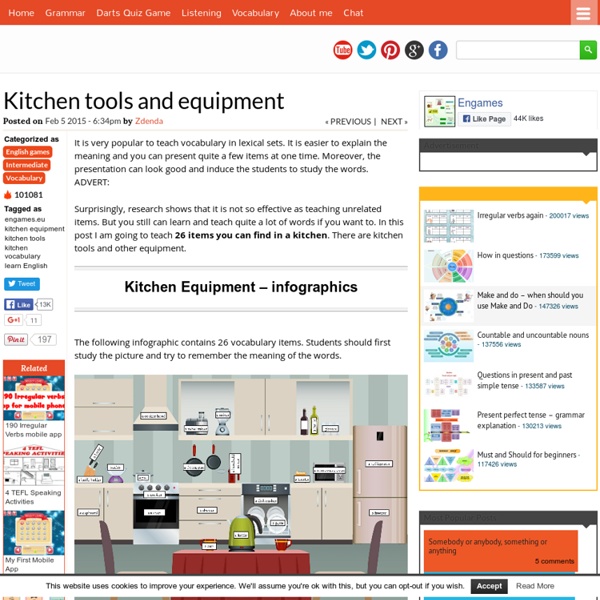Kitchen tools and equipment
It is very popular to teach vocabulary in lexical sets. It is easier to explain the meaning and you can present quite a few items at one time. Moreover, the presentation can look good and induce the students to study the words. Surprisingly, research shows that it is not so effective as teaching unrelated items. Kitchen Equipment – infographics The following infographic contains 26 vocabulary items. © Macrovector | Dreamstime.com You can practise or learn the correct pronunciation of the words in the following video. Kitchen Equipment – quizzes The methods above are fine to introduce the words and their meaning. If you do not like doing quizzes on the screen, you can print out the following pdf files and use them instead. Kitchen words_key Kitchen words_ws If you would like to have all the exercises in one file, download the following file. kitchen and tools vocabulary_full Kitchen vocabulary – share KITCHEN EQUIPMENT (Web)
ESL FUN GAMES FOR CLASSROOMS GAMES
ESL Powerpoint (PPT) Games If you are the type of person who prefers to have games on powerpoint or as printable handouts, we have been thinking of you. We offer board games, powerpoint games and more for the classroom and one to one teaching. They have made my lessons fun and I have no doubt yours will be fun too. Added to the good news are the templates we offer that you can use to create customized games for your classroom and teaching. It is total fun and highly engaging fun lessons with these resources. Printable ESL Board and Card Games We offer a variety of printable ESL board games and card games to help give your students lots of communicative practice. ESL Board & Powerpoint Games Templates ESL Game Templates - Powerpoint and Word Game Templates On ESL Games World we do not only aim at providing you with games for your classrooms. Classroom Tools - Click Here! Get some cool tools for use in your classroom. ESL Powerpoint (PPT) Games Printable ESL Board and Card Games
English Lessons for Kids, Multimedia Interactive Materials for Teaching Kids
In this section you will find video lessons and self-grading quizzes put according to topics and the developmental stages of the students. The online videos make for an excellent online classroom where students can study with minimal guidance. The video lesson slides are so well-designed, little or no explaining is needed. It is collection of many years of teaching in various classrooms across the globe. Course 1 - Lessons - Alphabet, Greetings, Colours, Ages, Numbers 1 to 10, Fruits and more>>> Course 2 - Lessons - Animals, Food, Family, Shapes, School bag, Weather, Toys, Days and more>>> Course 3 - Pets, Time& Daily Routines, Transport, Clothes, Home, Prepositions of place and more>>> ESL kids lab's quizzes have been carefully designed to teach kids how to spell, read, write and reinforce vocabulary. With these interactive quizzes, vocabulary and language points learnt with the videos is further reinforced and consolidated.
Story Cubes: Ten Teaching Ideas – ELT Experiences
A few months ago, I decided to invest in some Story Cubes and have been trying them out with some of my classes. If you are unfamiliar with Story Cubes, they are a collection of nine dice with images printed on each side of the dice. They are stored in a convenient box which is super portable, with them being small enough to just place in your pocket. In this article, we look at ten teaching ideas for using Story Cubes in the classroom. 1. The Story Cubes can be used as they were originally created for. When playing with family and friends take turns as the storyteller. If you are still a little unsure, here is a video of Rory using the Story Cubes. 2. Rather than using all 9 cubes, you could place all cubes into a bag and get one student to the front of the class. This idea is best suited for stronger learners of Intermediate or above. 3. If you have been focusing on grammar, you could use the cubes to help creatively review the key grammar from the lesson. 4. 5. 6. 7. 8. 9. 10.
Related:
Related:



